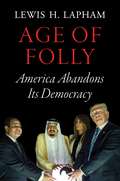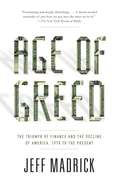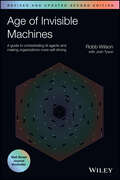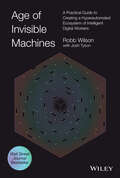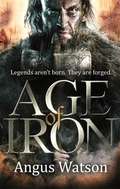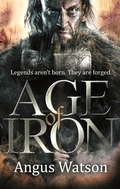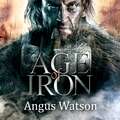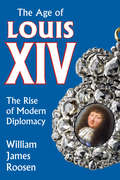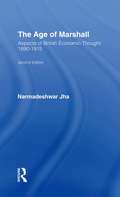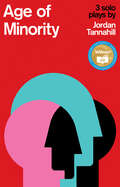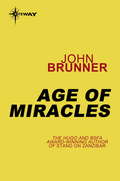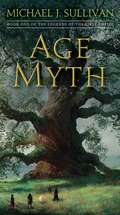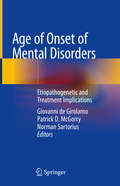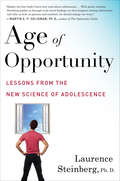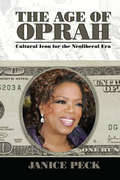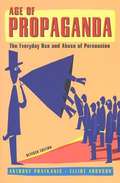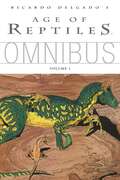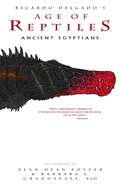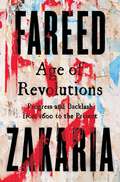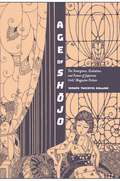- Table View
- List View
Age of Folly: America Abandons Its Democracy
by Lewis H. LaphamAmerica's leading essayist on the frantic retreat of democracy, in the fire and smoke of the war on terrorIn twenty-five years of imperial adventure, America has laid waste to its principles of democracy. The self-glorifying march of folly steps off at the end of the Cold War, in an era when delusions of omnipotence allowed the market to climb to virtual heights, while society was divided between the selfish and frightened rich and the increasingly debt-ridden and angry poor. The new millennium saw the democratic election of an American president nullified by the Supreme Court, and the pretender launching a wasteful, vainglorious and never-ending war on terror, doomed to end in defeat and the loss of America's prestige abroad.All this culminates in the sunset swamp of the 2016 election--a farce dominated by Donald Trump, a self-glorifying photo-op bursting star-spangled bombast in air. This spectacle would be familiar to Aristotle, whose portrayal of the "prosperous fool" describes a class of people who "consider themselves worthy to hold public office, for they already have the things that give them a claim to office."From the Hardcover edition.
Age of Greed: The Triumph of Finance and the Decline of America, 1970 to the Present
by Jeff MadrickA vividly told history of how greed bred America's economic ills over the last forty years, and of the men most responsible for them.As Jeff Madrick makes clear in a narrative at once sweeping, fast-paced, and incisive, the single-minded pursuit of huge personal wealth has been on the rise in the United States since the 1970s, led by a few individuals who have argued that self-interest guides society more effectively than community concerns. These stewards of American capitalism have insisted on the central and essential place of accumulated wealth through the booms, busts, and recessions of the last half century, giving rise to our current woes.In telling the stories of these politicians, economists, and financiers who declared a moral battle for freedom but instead gave rise to an age of greed, Madrick traces the lineage of some of our nation's most pressing economic problems. He begins with Walter Wriston, head of what would become Citicorp, who led the battle against government regulation. He examines the ideas of economist Milton Friedman, who created the plan for an anti-Rooseveltian America; the politically expedient decisions of Richard Nixon that fueled inflation; the philosophy of Alan Greenspan, on whose libertarian ideology a house of cards was built on Wall Street; and the actions of Sandy Weill, who constructed the largest financial institution in the world, which would have gone bankrupt in 2008 without a federal bailout of $45 billion. Significant figures including Ivan Boesky, Michael Milken, Jack Welch, and Ronald Reagan play key roles as well.Intense economic inequity and instability is the story of our age, and Jeff Madrick tells it with style, clarity, and an unerring command of his subject.From the Hardcover edition.
Age of Icons
by Martijn Konings Gavin FridellCelebrities are increasingly front and centre in public debates on everything from solving world poverty to halting genocide, confronting obesity, and finding spiritual contentment. Bono, Bill Gates, Al Gore, Bob Geldof, Oprah, Madonna, and Angelina Jolie are just some of the entertainers, politicians, pundits, elite business people, and policy-makers whose highly visible political activism has become an integral part of their public personas.These pop icons tend to be celebrated as "philanthrocapitalists" with a unique ability to remedy the world's problems. However, as Age of Icons demonstrates, the solutions these icons promote for addressing global injustice, when examined critically, can be seen to work through the very same institutions that create these problems in the first place.This volume assesses the growing role of popular icons in the construction of a culture that appears to incorporate a critical attitude towards the capitalist experience while, in fact, legitimizing the neoliberal character of the modern world. It will be an eye-opening read for anyone interested in the juncture between current events and celebrity culture.
Age of Invisible Machines: A Guide to Orchestrating AI Agents and Making Organizations More Self-Driving, Revised and Updated
by Robb Wilson Josh TysonCut through the noise and unlock the transformational power of conversational AI In the newly revised second edition of Age of Invisible Machines, renowned tech leader Robb Wilson delivers a startlingly insightful and eye-opening blueprint for using conversational AI to make your company self-driving—with a digital ecosystem of interconnected automations powering all aspects of your business. Conversational AI is transforming every job at every company (starting yesterday) and this book is perfect for anyone affected by these technologies. You'll learn how to develop a hyperautomation strategy by identifying outdated processes and systems holding your company back. This latest edition offers brand new chapters dedicated to fast-growing automation tools, including Large Language Models, generative AI, and much more. You'll discover ways to implement new technologies that are force-multipliers for rapid growth. A must-read for every business leader, Wilson's book debunks common myths about conversational AI while simplifying the inevitable complexity of restructuring your business to unlock the substantial opportunities this new era offers. You'll also find: Incisive discussions of the ethical dilemmas that lie before us as mass adoption of conversational AI takes effect Fascinating examinations of what a self-driving business looks like and how you can use conversational AI to generate an enduring competitive advantage Strategies for creating a hyperautomated ecosystem that any company can begin using immediately QR links to interactive and ongoing discussions of the subjects covered in each chapter A practical and essential exploration of the future of conversational AI and hyperautomation, Age of Invisible Machines belongs in the hands of entrepreneurs, founders, business leaders, tech enthusiasts, designers and anyone else with a stake in the future of business.
Age of Invisible Machines: A Practical Guide to Creating a Hyperautomated Ecosystem of Intelligent Digital Workers
by Robb WilsonCut through the hype and unlock the game-changing potential of conversational AI. In Age of Invisible Machines, celebrated tech leader Robb Wilson delivers an eye-opening and startlingly insightful blueprint for leveraging conversational AI in order to make your organization self-driving—with a growing ecosystem of interconnected automations accelerating all aspects of your business. Conversational AI is changing the nature of every job at every company (starting yesterday) and this book is relevant for anyone who will be affected by the acceleration of these technologies. You&’ll learn how to develop a strategy for hyperautomation by identifying the outdated processes and systems holding your organization back. You&’ll discover ways of internalizing and orchestrating new technologies that are force-multipliers for rapid growth. A must-read for every business leader, Wilson&’s book debunks common myths about conversational AI while laying bare the inevitable complexity of restructuring your business to unlock the massive opportunities this new era affords. You&’ll also find: Compelling discussions of the ethical dilemmas that lie in wait as mass adoption of conversational AI takes hold Fascinating explorations of what a self-driving organization looks like and how you can use conversational AI to create a durable competitive advantage Strategies behind creating an ecosystem for hyperautomation that any company can begin implementing immediately QR links to ongoing, interactive online discussions of the material covered in each chapter An essential and practical discussion of the future of conversational AI and hyperautomation, Age of Invisible Machines belongs in the hands of founders, entrepreneurs, business leaders, designers, tech enthusiasts, and anyone else with a stake in the future of business.
Age of Iron (Iron Age #1)
by Angus WatsonLEGENDS AREN'T BORN. THEY'RE MADE.Dug Sealskinner is a down-on-his-luck mercenary traveling south to join up with King Zadar's army. But he keeps rescuing the wrong people.First Spring, a child he finds scavenging on the battlefield, and then Lowa, one of Zadar's most fearsome warriors, who has vowed revenge on the king for her sister's execution.Now Dug's on the wrong side of the thousands-strong army he hoped to join -- and worse, Zadar has bloodthirsty druid magic on his side. All Dug has is his war hammer, one small child, and one unpredictable, highly-trained warrior with a lust for revenge that might get them all killed . . .
Age of Iron (The Iron Age Trilogy #1)
by Angus WatsonLEGENDS AREN'T BORN. THEY'RE FORGED.Dug Sealskinner is a down-on-his-luck mercenary travelling south to join up with King Zadar's army. But he keeps rescuing the wrong people. First, Spring, a child he finds scavenging on the battlefield, and then Lowa, one of Zadar's most fearsome warriors, who's vowed revenge on the king for her sister's execution. Now Dug's on the wrong side of that thousands-strong army he hoped to join - and worse, Zadar has bloodthirsty druid magic on his side. All Dug has is his war hammer, one rescued child and one unpredictable, highly-trained warrior with a lust for revenge that's going to get them all killed . . . It's a glorious day to die.Look out now for YOU DIE WHEN YOU DIE - first in a new historical fantasy series from Angus Watson.'Watson's tale is gore soaked and profanity laden - full of visceral combat and earthy humor, and laced with subtle magic. The blend of historical accuracy and authorial liberties suggests an old-school sword-and-sorcery epic, though with some modern sensibilities thrown in for good measure!' PUBLISHERS WEEKLY'Would I read the next one? Yes, absolutely. Bring me my hammer, bring my beer, bring it on.' SF CROWSNEST'Watson has created a brilliant and confident debut . . . If you like your fantasy packed with hammer-wielding heroes, bloodthirsty druids, strong female leads, action, intrigue, betrayal, and a brilliantly conceived world then AGE OF IRON is for you.' THE BOOK BEARD'Thoroughly entertaining from the get go . . . I really got a kick out of the AGE OF IRON'THE ELOQUENT PAGEFor more epic action from Angus Watson, check out:West of West TrilogyYou Die When You DieThe Land you Never LeaveWhere Gods Fear to GoThe Iron Age TrilogyAge of IronClash of IronReign of Iron
Age of Iron (The Iron Age Trilogy)
by Angus WatsonLEGENDS AREN'T BORN. THEY'RE MADE. Dug Sealskinner is a down-on-his-luck mercenary travelling south to join up with King Zadar's army. But he keeps rescuing the wrong people. First, Spring, a child he finds scavenging on the battlefield, and then Lowa, one of Zadar's most fearsome warriors, who's vowed revenge on the king for her sister's execution. Now Dug's on the wrong side of that thousands-strong army he hoped to join - and worse, Zadar has bloodthirsty druid magic on his side. All Dug has is his war hammer, one rescued child and one unpredictable, highly-trained warrior with a lust for revenge that's going to get them all killed . . . It's a glorious day to die.
Age of Jihad: Islamic State and the Great War for the Middle East
by Patrick CockburnFrom the award-winning author of The Rise of Islamic State, the essential story of the Middle East's disintegrationThe Age of Jihad charts the turmoil of today's Middle East and the devastating role the West has played in the region from 2001 to the present. Beginning with the US-led invasion of Afghanistan, Cockburn explores the vast geopolitical struggle that is the Sunni-Shia conflict, a clash that shapes the war on terror, western military interventions, the evolution of the insurgency, the civil wars in Yemen, Libya and Syria, the Arab Spring, the fall of regional dictators, and the rise of Islamic State. As Cockburn shows in arresting detail, Islamic State did not explode into existence in Syria in the wake of the Arab Spring, as conventional wisdom would have it. The organization gestated over several years in occupied Iraq, before growing to the point where it can threaten the stability of the whole region. Cockburn was the first Western journalist to warn of the dangers posed by Islamic State. His originality and breadth of vision make The Age of Jihad the most in-depth analysis of the regional crisis in the Middle East to date.From the Hardcover edition.
Age of Louis XIV: The Rise of Modern Diplomacy
by William James RoosenWilliam James Roosen has written the first general study of European diplomacy in the age of Louis XIV which is based on the actual practices and institutions of that era, rather than on the writing of early theoreticians.Though the seventeenth century may not have been a period of great innovations in international diplomacy, it provides us with an important illustration of the "workings of a system which was well suited to the gradually changing needs of its time" and which has been called "the best form of diplomacy ever developed."Dr. Roosen demonstrates both the obvious differences and the many similarities between diplomatic procedures and practices of the seventeenth century and the twentieth. Any student of diplomacy and international relations will gain valuable insight and understanding from this study of the early modern diplomatic personalities, institutions, and practices.One of Dr. Roosen's goals in writing this book has been to discover the relationships between the ideological and socioeconomic structures and the diplomatic personalities who have influenced modern diplomacy. Further, he supplies the only available study of the realities of diplomatic practices in seventeenth century Europe, and provides an excellent basis for comparison with twentieth century international relations, in the hope that "studying early modern diplomatic personalities, institutions and practices should increase our understanding of international relations today."There are chapters on "The States of Europe," "Kings and Ministers," "Ambassadors," "Second Class Diplomats," "A Typical Early Modern Embassy," "Information: Important Objective of Diplomatic Activity," and "The Variety of Diplomatic Duties.
Age of Marshall: Aspects of British Economic Thought
by Narmedeshwar JhaFirst published in 1973. This is the second edition and nine years after when The Age of Marshall was first published. The period 1890-1915 in the history of British Economic Thought may aptly be described as the Age of Marshall. His influence as teacher, and his ideas as presented in the Principles of Economics (1890) and other writings, stimulated and often dominated the ideas and writings of most of the younger economists of the period. His ideas also provided a theoretical basis for increasing state intervention in economic life of the community in Britain and thus helped the Liberal Government of Great Britain lay the foundations of a Welfare State.
Age of Minority: Three Plays by Jordan Tannahill
by Jordan TannahillBased on a true story, Get Yourself Home Skyler James follows the harrowing journey of a young lesbian who defects from the army when she is outed by fellow soldiers. Peter Fechter: 52 Minutes chronicles the last hour of Peter Fechter's life, a teenager in East Berlin shot while attempting to cross the Berlin Wall in 1962 with his companion. Finally, rihannaboi95 centres around a Toronto teen whose world comes crashing in when YouTube videos of him dancing to songs by his favourite pop heroine go viral. Together these solo plays explore the lives of three queer youth and their resilience in the face of violence and intolerance.
Age of Miracles
by John BrunnerWhen suddenly all the fissionable material on Earth was exploded, Earthmen had their first notice of the aliens' arrival. And by the time the panic, death and chaos had been sorted out, reports were coming in about mysterious cities scattered across the face of the planet - huge areas of flickering light and awesome free energy, disorienting to human senses and impregnable to attack. The question was: were they alien bases . . . or something else?
Age of Miracles
by John BrunnerWhen suddenly all the fissionable material on Earth was exploded, Earthmen had their first notice of the aliens' arrival. And by the time the panic, death and chaos had been sorted out, reports were coming in about mysterious cities scattered across the face of the planet - huge areas of flickering light and awesome free energy, disorienting to human senses and impregnable to attack. The question was: were they alien bases...or something else?
Age of Myth: Book One of The Legends of the First Empire (The Legends of the First Empire #1)
by Michael J. SullivanMichael J. Sullivan's trailblazing career began with the breakout success of his Riyria series: full-bodied, spellbinding fantasy adventures whose imaginative scope and sympathetic characters won a devoted readership and comparisons to fantasy masters Brandon Sanderson, Scott Lynch, and J.R.R. Tolkien himself. Now Sullivan's stunning hardcover debut, Age of Myth, inaugurates an original five-book series--and one of fantasy's finest next-generation storytellers continues to break new ground. Since time immemorial, humans have worshipped the gods they call Fhrey, truly a race apart: invincible in battle, masters of magic, and seemingly immortal. But when a god falls to a human blade, the balance of power between humans and those they thought were gods changes forever. Now only a few stand between humankind and annihilation: Raithe, reluctant to embrace his destiny as the God Killer; Suri, a young seer burdened by signs of impending doom; and Persephone, who must overcome personal tragedy to lead her people. The Age of Myth is over. The time of rebellion has begun.Praise for Michael J. Sullivan "Hair-raising escapes, flashy sword fights, and faithful friendship complete the formula for good old-fashioned escapist fun."--Publishers Weekly, on Theft of Swords "Filled with adventure and clever dialog and featuring a pair of not-quite-heroes whose loyalties to each other provide them with their greatest strength, this epic fantasy showcases the arrival of a master storyteller."--Library Journal, on Theft of Swords "With less gore and a smaller cast of characters than George R. R. Martin's Song of Ice and Fire but equally satisfying, Sullivan's epic fantasy will be gaining fans at exponential rates."--Library Journal, on The Rose and the ThornFrom the Hardcover edition.
Age of Onset of Mental Disorders: Etiopathogenetic and Treatment Implications
by Norman Sartorius Giovanni De Girolamo Patrick D. McGorryThis book presents a thorough and critical review of current knowledge about the age of onset of mental disorders. The opening chapters offer information about the impact of the age of onset on the clinical picture, course, and outcome of physical illnesses, and about the neurobiological implications and correlates of different ages of onset. The impact and correlates of the ages of onset of all the most important mental disorders are then discussed in detail by internationally renowned scientists. The background to the book is the recognition that a better understanding of age of onset makes it possible to estimate the lifetime risk of disorders, helps to elucidate pathogenesis, and facilitates efficient, targeted clinical management. The book will be of value for clinicians, mental health professionals, mental health researchers, epidemiologists, and different stakeholders in the mental health field.
Age of Opportunity
by Laurence SteinbergA leading authority draws on new research to explain why the adolescent years are so developmentally crucial, and what we must do to raise happier, more successful kids.Adolescence now lasts longer than ever before. And as world-renowned expert on adolescent psychology Dr. Laurence Steinberg argues, this makes these years the key period in determining individuals' life outcomes, demanding that we change the way we parent, educate, and understand young people.In Age of Opportunity, Steinberg leads readers through a host of new findings -- including groundbreaking original research -- that reveal what the new timetable of adolescence means for parenting 13-year-olds (who may look more mature than they really are) versus 20-somethings (who may not be floundering even when it looks like they are). He also explains how the plasticity of the adolescent brain, rivaling that of years 0 through 3, suggests new strategies for instilling self-control during the teenage years. Packed with useful knowledge, Age of Opportunity is a sweeping book in the tradition of Reviving Ophelia, and an essential guide for parents and educators of teenagers.
Age of Oprah: Cultural Icon for the Neoliberal Era (Media and Power)
by Janice PeckOver the last two decades Oprah Winfrey's journey has taken her from talk show queen to-as Time Magazine has asserted-"one of the most important figures in popular culture." Through her talk show, magazine, website, seminars, charity work, and public appearances, her influence in the social, economic, and political arenas of American life is considerable and until now, largely unexamined. In The Age of Oprah, media scholar and journalist Janice Peck traces Winfrey's growing cultural impact and illustrates the fascinating parallels between her road to fame and fortune and the political-economic rise of neoliberalism in this country. While seeking to understand Oprah's ascent to the near- iconic status that she enjoys today, Peck's book provides a fascinating window into the intersection of American politics and culture over the past quarter century.
Age of Propaganda: The Everyday Use and Abuse of Persuasion
by Elliot Aronson Anthony H. PratkanisAmericans create 57% of the world's advertising while representing only 6% of its population; half of our waking hours are spent immersed in the mass media. Persuasion has always been integral to the democratic process, but increasingly, thoughtful discussion is being replaced with simplistic soundbites and manipulative messages. Drawing on the history of propaganda as well as on contemporary research in social psychology, Age of Propaganda shows how the tactics used by political campaigners, sales agents, advertisers, televangelists, demagogues, and others often take advantage of our emotions by appealing to our deepest fears and most irrational hopes, creating a distorted vision of the world we live in. This revised and updated edition includes coverage of the Clinton/Lewinsky scandal, recent election campaigns, talk radio, teen suicide, U. F. O. abductions, the Columbine shootings, and novel propaganda tactics based on hypocrisy and false allegations.
Age of Reptiles Omnibus: Volume 1 (Age of Reptiles)
by Ricardo DelgadoWhen Ricardo Delgado—a prolific development and storyboard artist who has worked on such hit films as Men in Black, The Incredibles, WALL-E, X—Men Origins: Wolverine, and the Matrix series—first set his sights on creating comics, he crafted an epic tale about the most unlikely cast of characters: dinosaurs. Since that first foray into the world of sequential art—which earned him an Eisner win for Talent Deserving of Wider Recognition—he has returned to his critically acclaimed Age of Reptiles again and again, each time crafting a captivating saga about his saurian subjects.* This volume collects the long—out—of—print Age of Reptiles and Age of Reptiles: The Hunt, and the never—before—collected third series, Age of Reptiles: The Journey."Delgado once more proves that the age of great illustration is alive and well." —John Landis, Filmmaker, An American Werewolf in London, Michael Jackson's Thriller
Age of Reptiles: Ancient Egyptians
by Ricardo DelgadoOne of the most beloved and respected comic book series returns as Ricardo Delgado's Age of Reptiles: Ancient Egyptians series marks a bold, new direction in wordless storytelling. The steaming swamps of Cretaceous Africa teem with prehistoric life and primordial danger in a tale filled with villains, victims, and one of the most dangerous and unpredictable protagonists ever created. Watch the lone, lonely anti-hero Spinosaurus Aegypticus as he faces a swamp full of dangerous, double-crossing dinosaurs in a plot-twisting parable that will remind you of the classic spaghetti western and the noble samurai tales of yore.
Age of Revolutions: Progress and Backlash from 1600 to the Present
by Fareed ZakariaThe CNN host and best-selling author explores the revolutions—past and present—that define the polarized and unstable age in which we live. <p><p> Populist rage, ideological fracture, economic and technological shocks, war, and an international system studded with catastrophic risk—the early decades of the twenty-first century may be the most revolutionary period in modern history. But it is not the first. Humans have lived, and thrived, through more than one great realignment. What are these revolutions, and how can they help us to understand our fraught world? <p><p> In this major work, Fareed Zakaria masterfully investigates the eras and movements that have shaken norms while shaping the modern world. Three such periods hold profound lessons for today. First, in the seventeenth-century Netherlands, a fascinating series of transformations made that tiny land the richest in the world—and created politics as we know it today. Next, the French Revolution, an explosive era that devoured its ideological children and left a bloody legacy that haunts us today. Finally, the mother of all revolutions, the Industrial Revolution, which catapulted Great Britain and the US to global dominance and created the modern world. <p><p> Alongside these paradigm-shifting historical events, Zakaria probes four present-day revolutions: globalization, technology, identity, and geopolitics. For all their benefits, the globalization and technology revolutions have produced profound disruptions and pervasive anxiety and our identity. And increasingly, identity is the battlefield on which the twenty-first century’s polarized politics are fought. All this is set against a geopolitical revolution as great as the one that catapulted the United States to world power in the late nineteenth century. Now we are entering a world in which the US is no longer the dominant power. As we find ourselves at the nexus of four seismic revolutions, we can easily imagine a dark future. But Zakaria proves that pessimism is premature. If we act wisely, the liberal international order can be revived and populism relegated to the ash heap of history. <p><p> As few public intellectuals can, Zakaria combines intellectual range, deep historical insight, and uncanny prescience to once again reframe and illuminate our turbulent present. His bold, compelling arguments make this book essential reading in our age of revolutions. <p> <b>New York Times Bestseller</b>
Age of Secession
by Griffiths Ryan D.What are the factors that determine how central governments respond to demands for independence? Secessionist movements are numerous and quite varied in form, but the chief obstacle to their ambitions is the state itself, which can deny independence demands, deploy force if need be, and request that the international community respect its territorial integrity by not recognizing the breakaway region. Age of Secession focuses on this crucial but neglected moment in the life of a secessionist movement. Griffiths offers a novel theory using original data on secessionist movements between 1816 and 2011. He explains how state response is shaped by international and domestic factors, when conflict is likely, and why states have proliferated since 1945. He mixes quantitative methods with case studies of secessionist movements in the United Kingdom, Russia/Soviet Union, and India. This is an important book for anyone who wants to understand the phenomenon of secession.
Age of Shōjo: The Emergence, Evolution, and Power of Japanese Girls' Magazine Fiction
by Hiromi Tsuchiya DollaseHiromi Tsuchiya Dollase examines the role that magazines have played in the creation and development of the concept of shōjo, the modern cultural identity of adolescent Japanese girls. Cloaking their ideas in the pages of girls' magazines, writers could effectively express their desires for freedom from and resistance against oppressive cultural conventions, and their shōjo characters' "immature" qualities and social marginality gave them the power to express their thoughts without worrying about the reaction of authorities. Dollase details the transformation of Japanese girls' fiction from the 1900s to the 1980s by discussing the adaptation of Western stories, including Louisa May Alcott's Little Women, in the Meiji period; the emergence of young female writers in the 1910s and the flourishing girls' fiction era of the 1920s and 1930s; the changes wrought by state interference during the war; and the new era of empowered postwar fiction. The book highlights seminal author Yoshiya Nobuko's dreamy fantasies and Kitagawa Chiyo's social realism, Morita Tama's autobiographical feminism, the contributions of Nobel Prize–winning author Kawabata Yasunari, and the humorous modern fiction of Himuro Saeko and Tanabe Seiko. Using girls' perspectives, these authors addressed social topics such as education, same-sex love, feminism, and socialism. The age of shōjo, which began at the turn of the twentieth century, continues to nurture new generations of writers and entice audiences beyond age, gender, and nationality.
